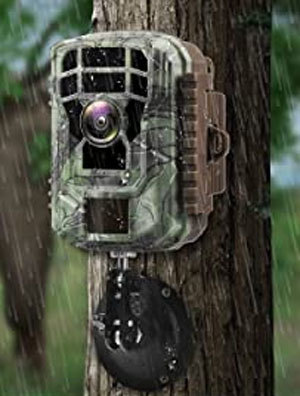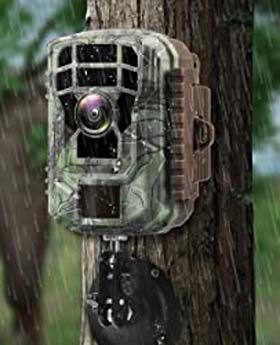 Many people run their cameras year-round. So they expect their trail cameras to stand up to the most punishing environmental conditions while operating the entire time, recording images onto the SD card, and detecting movement without any problem.
Many people run their cameras year-round. So they expect their trail cameras to stand up to the most punishing environmental conditions while operating the entire time, recording images onto the SD card, and detecting movement without any problem.
We talk a lot about trail cameras on this website and we commonly hear a few questions as they relate to a trail cameras ability to withstand the elements:
- Are trail cameras waterproof?
- Are trail cameras weatherproof?
- What does IP56 mean?
- What does IP66 mean?
Knowing the answers to these questions is very important if you want to feel confident that the trail camera you are about to buy can make it through whatever mother nature throws its way.
Table of Contents
What is waterproof?
If you check at the real meaning of the term “waterproof,” it means that something is impervious to water. However, when some people say that something is waterproof they refer to it as being water-repellent, water-tight, and water-resistant, which don’t all mean the same things. So in other words, the term is open to explanation.
When most individuals ask if their trail camera is waterproof, what they actually want or need to know if their trail camera will withstand heavy rains, snow, and, in some instances, being totally submerged in water.
What is weatherproof?
Weatherproof refers to the device’s capacity to withstand exposure to weather without loss of function or damage. Therefore, a weatherproof trail camera means that it doesn’t allow wind or rain to go through or enter the camera. A weatherproof trail camera can be exposed to any element of weather and cannot be affected.
IP Protection (IP Ratings)
When you look at the packaging for trail cameras or when you read their product descriptions online you will notice that most of the manufacturers list each camera’s IP rating to promote its ability to withstand the elements. However, they really don’t explain what these IP ratings mean. So let’s take a minute to explain how these IP ratings work.
IP stands for, ingress protection, and the ratings for a device contain the letters IP, followed by a two-digit number and a non-compulsory letter. As described in IEC 60529 (International standard), it categorizes the levels of protection offered against solids, dust, water, and accidental contact inside electrical enclosures. These norms offer consumers more details than imprecise marketing terms like waterproof.
While products that are intended for indoor use have standards they must adhere to most people are more concerned with the level of protection that is offered for items, like trail cameras, that they will be using outside.
Numerology (What Do the Numbers in IP Ratings Mean?)
The initial digit shows the size of elements (for example, particulate matter, including dust) that will be excluded. Meanwhile, the second digit provides information about resistance to water ingress.
If an “X” represents either of those digits (the initial one, most commonly). It does not mean it provides no safety from that object, only that the producer does not claim a particular ranking for it.
Logically, the X in place of the first character simply means that: if a tool can resist the ingress of water, it is also like protecting the ingress of components such as dust or sand. Therefore, some sellers depend on the user’s common sense to evade the expense of examining for non-liquid ingress. That is why a ranking such as IPX7 is relatively common.
Let’s break down the values for both the first and second digits so we can see exactly what they protect against.
First Number in IP Ratings (Solids)
| Level | Object Size Protected Against | Effective Against |
|---|---|---|
| 0 | Not protected | No protection against contact and ingress of objects |
| 1 | >50mm | Any large surface of the body, such as the back of the hand, but no protection against deliberate contact with a body part. |
| 2 | >12.5mm | Fingers or similar objects. |
| 3 | >2.5mm | Tools, thick wires, etc. |
| 4 | >1mm | Most wires, screws, etc. |
| 5 | Dust Protected | Ingress of dust is not entirely prevented, but it must not enter in sufficient quantity to interfere with the satisfactory operation of the equipment; complete protection against contact. |
| 6 | Dust Tight | No ingress of dust; complete protection against contact. |
Second Number in IP Ratings (Liquids)
| Level | Object Size Protected Against | Effective Against |
|---|---|---|
| 0 | Not Protected | - |
| 1 | Dripping Water | Dripping water (vertically falling drops) shall have no harmful effect. |
| 2 | Dripping Water When Tilted Up to 15° | Vertically dripping water shall have no harmful effect when the enclosure is tilted at an angle up to 15° from its normal position. |
| 3 | Spraying Water | Water falling as a spray at any angle up to 60° from the vertical shall have no harmful effect. |
| 4 | Splashing Water | Water splashing against the enclosure from any direction shall have no harmful effect. |
| 5 | Water Jets | Water projected by a nozzle (6.3mm) against enclosure from any direction shall have no harmful effects. |
| 6 | Powerful Water Jets | Water projected in powerful jets (12.5mm nozzle) against the enclosure from any direction shall have no harmful effects. |
| 7 | Immersion up to 1m | Ingress of water in harmful quantity shall not be possible when the enclosure is immersed in water under defined conditions of pressure and time (up to 1 m of submersion). |
| 8 | Immersion beyond 1m | The equipment is suitable for continuous immersion in water under conditions which shall be specified by the manufacturer. Normally, this will mean that the equipment is hermetically sealed. However, with certain types of equipment, it can mean that water can enter but only in such a manner that it produces no harmful effects. |
Trail Camera IP Ratings
When you see the IP ratings for trail cameras they will always have an ingress protection value listed for both solids and liquids. The two IP values that you will most commonly see for trail cameras these days are IP56 and IP66.
So let’s see what those two ratings mean using the information that we learned from the tables listed above.
So What is the IP56 Rating?
An IP56 rating means that the trail camera has a protection level of 5 from solids and a protection level of 6 from liquids. So let’s see what they protect against.
Solids Level 5 – Dust Protected, which means ingress of dust is not entirely prevented, but it doesn’t enter in sufficient quantity to interfere with the satisfactory operation of the equipment; complete protection against contact.
Liquids Level 6 – Powerful Water Jets, which means that water projected in powerful jets (12.5mm nozzle) against the enclosure (case) from any direction shall have no harmful effects.
So a trail camera with an IP56 rating won’t let any large debris into the camera and any dust that might enter will be small enough and in such low amounts that won’t keep the camera from operating properly. You should also feel comfortable leaving the camera out in all weather conditions because hard rain or snow won’t penetrate the camera’s outer case.
So What is the IP66 Rating?
An IP66 rating means that the trail camera has a protection level of 6 from solids and a protection level of 6 from liquids. So let’s see what they protect against.
Solids Level 6 – Dust Tight, which means it is completely protected against the ingress of dust and other solids; complete protection against contact.
Liquids Level 6 – Powerful Water Jets, which means that water projected in powerful jets (12.5mm nozzle) against the enclosure (case) from any direction shall have no harmful effects.
So a trail camera with an IP66 rating won’t let any dust or debris into the camera case. You should also feel confident in leaving the camera out in all weather conditions as both hard rain or snow won’t penetrate the camera’s outer case.
IP56 versus IP66
If you don’t know anything about IP ratings and see that one trail camera has an IP66 rating and are comparing it to a camera that has an IP56 rating you might think that the IP66 camera is 10 levels of protection better than the IP56 model, which seems pretty impressive. However, from what we just learned we know that simply isn’t the case.
The only real difference between IP56 trail cameras and IP66 trail cameras is that the IP66 cameras have one level higher ingress protection against solids. Both IP ratings mean that the camera is protected against larger solids, but the difference has to do with dust being able to get inside the camera. The IP56 trail cameras might allow some very small specs of dust to enter the camera’s casing, but any dust that enters shouldn’t be enough to prevent the camera from operating properly. Meanwhile, the IP66 cameras will be completely protected from dust entering the camera case.
Do Any Trail Cameras Have IP57, IP58, IP67, or IP68 Ratings?
I wouldn’t be surprised if some trail cameras had these ratings in the future, but I haven’t seen any camera that currently has those IP ratings.
However, it wouldn’t surprise me if we saw some trail cameras have those IP ratings at some point in the future. It would certainly be a great marketing tactic to be able to say that your trail camera resists water better than the other cameras on the market.
So Are Trail Cameras Waterproof?
As we mentioned earlier the term “waterproof” means that the object in question is impervious to water. We also know that the Level 6 liquid rating doesn’t offer protection to trail cameras, or any other products while being submerged in water. This means that you don’t want to accidentally drop them into the water or post them low to the ground in places that are prone to flooding.
So no, trail cameras are not waterproof, but it is fair to call them weatherproof.
Are SD Cards Water-Resistant?
So what happens if your trail camera fails and water penetrates the camera case? Are SD cards water-resistant? Will the pictures and videos that are on the card be OK.
The answer is yes, in most instances.
For instance, if you look at the SanDisk site they have a webpage detailing what their memory cards can withstand. Essentially, SanDisk declares that their SD cards are examined to cope with submersion in saltwater for up to seventy-two hours with an Ingress Protection rating of IPX7. The good news is that if your trail camera does get wet, at least you will be capable of retrieving data off the SD card.
I have never had one of my trail cameras fail and let water in, but it certainly has happened to other people. That said, I have accidentally run memory cards through the laundry and thankfully they still worked. I should also say that I usually buy SanDisk or other high-quality cards. High-quality cards might cost just a little bit more, but I think the extra dependability and durability are worth the small investment.
The lesser models of SD cards are not very rugged. When you do a quick search on YouTube, you will get a couple of tests on various brands of SD cards and how they withstand water ingress. As an extra layer of protection, you may want to consider keeping cards inside a water-resistant case, just to be safe.
Final Thoughts
Everyone knows that trail cameras are intended to be used outdoors and usually for extended periods of time. While trail cameras are not waterproof they certainly need to be, and are, weatherproof. So every camera you consider purchasing should have a rating of IP56 or IP66. While my initial instinct would be to gravitate toward the IP66 models and get complete protection from dust, I wouldn’t eliminate IP56 models from consideration, because as we discussed earlier the difference between these two ratings is very small. Plus, I have never had an issue with any IP56 trail cameras that I have purchased in the past.
So if I were looking at 2 trail cameras that had similar features and prices, but one camera had an IP66 rating while the other did not I would probably buy the IP66 camera. However, if I were debating between an IP56 and an IP66 camera I would have no problem buying the IP56 trail camera if it had better features or price.



